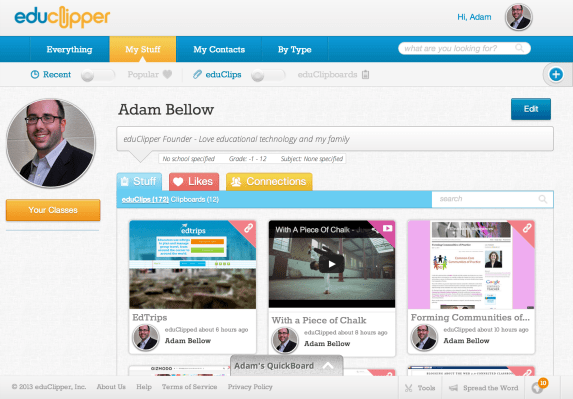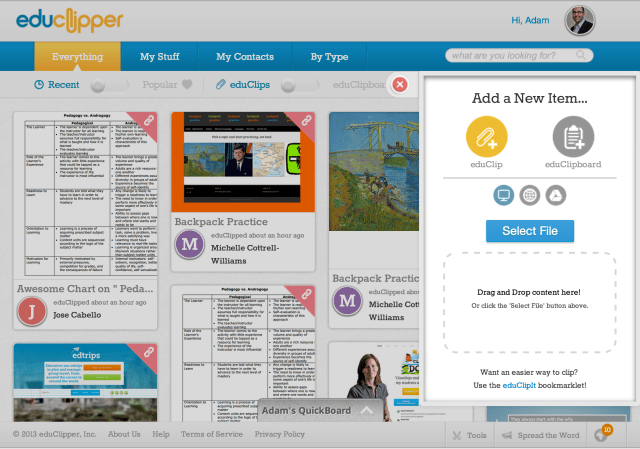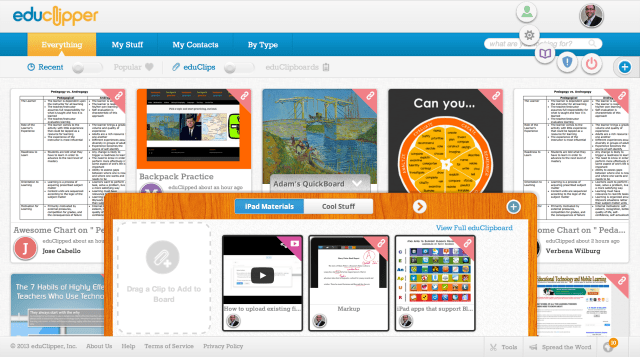Back in 2007, Adam Bellow launched a site called eduTecher to aggregate and surface the best educational resources and content on the web. A high school teacher, Bellow set out to highlight new technologies and educational tools that could be used in the classroom to improve the learning experience. When a new generation of community curation tools began to take hold on the web, like Pinterest, Bellow decided to leverage the increasing popularity of crowdsourced curation to take eduTecher to the next level.
This week the teacher-turned-entrepreneur officially launched eduClipper, a platform that allows teachers and students to explore, share and contribute to a library of educational content. In both function and design, it’s essentially a Pinterest for education, with one notable difference: Because eduClipper is built exclusively for teachers and students, unlike Pinterest, you probably won’t find it blocked by your local school. (Which should be welcome to news to teachers, who have become eager adopters of Pinterest over the last few years.)
The idea behind eduClipper, Bellow says, is to give students the same power of social curation they would have with Pinterest, allowing them to locate and publicly broadcast the best learning resources. In other words, educators and students can explore thousands of pieces of educational content, find lesson plans, resources and videos and search for the most popular content by subject or interest.
With eduClipper, users can share individual eduClips (or pieces of content) or eduClipboards (collections of content) with colleagues or students while cross-posting or embedding that content on other social platforms or sending them through email.
EduClips are created through the site’s bookmarklet (which work with all “modern browsers”), so once it’s installed in their browsers, teachers and students can grab any content they find on the web, Google Drive, Google Apps and more, and add them to their collection, i.e. their eduClipboards. Once grabbed, the site automatically grabs the source link, too, so that it’s easy to get back to the original content and easy to give proper citation.
Teachers and students can share these clipboards so that their classmates and colleagues can collaborate on assignments or in-class activities, create groups to share these resources with and align the content that’s clipped and shared to Common Core Standards. That’s the big advantage of eduClipper over Pinterest, that content can easily be organized and annotated for each class or subject by way of these learning collections. It also has the benefit of being created by a teacher who has spent the last five years searching for and curating the web’s best educational content.
“There’s a ton of great content on the web that we want to share with colleagues and students,” the eduClipper founder says. “But it becomes difficult to share because our students and teachers are not all connected in the same place.” So, beyond showcasing specific contributors, the platform also enables this real-time collaborative clipboarding for group work — something that’s increasingly becoming the norm in today’s classrooms.
Bellow also tells us that he wants the platform to go beyond group boards to enable the sharing and co-curating of community-generated content, both public and private, which he hopes will pave the way for better K-12 learning portfolios. A use case that could be of interest to EdTech startups like Pathbrite, which could help extend the functionality of the eduClipper platform and give teachers and students a way to create a multimedia (and more three-dimensional) record of their projects, experiments and credentials.
“In addition to finding and sharing content, eduClipper will allow teachers and students to post and share their best work, lesson ideas, and more to the global community,” Bellow continues. “In essence, we are going to be building a digital resource hub that empowers students to create and curate their own learning portfolios.”
Since the founder began development on eduClipper a little over a year ago, over 35K teachers have created accounts on the platform during alpha testing, with 300 classrooms having used the site over the past two weeks. To help build the product and early traction, the startup raised $600K from Learn Capital and Western Technologies (an early investor in Facebook). As the platform is now open to all teachers and students, Bellow is setting out to begin raising a series A round.
While the platform has appealing design and ease-of-use to recommend it, eduClipper is not without competition. EduCanvas, a startup out of Imagine K12’s third batch and the “Evernote-meets-Pinterest” clipping service, Clipboard, which was acquired by Salesforce.com have been attacking this space — not to mention the well-funded Grockit, which just raised $20 million to bring Learnist (its own social learning service / Pinterest for education) to the masses — just to name a few.
There’s enough interest in education and among schools for this kind of search, curation and clipboarding service that there should be plenty of greenfield, at least for awhile. But if this really catches fire, it’s hard to imagine the network effect not taking hold and giving most of the mindshare to one or two winners.
As it moves forward, look for eduClipper to differentiate itself from the competition by developing for mobile and by extending its platform to enable teachers to be more creative with the tools they use every day, whether it be YouTube, Slideshare, Prezi and more. If it hopes to win in this space, key concerns going forward will also be reliability, data portability and the ability to connect and integrate with other services and apps. The more open the better, or so the thinking goes.
For more, find eduClipper at home here.


